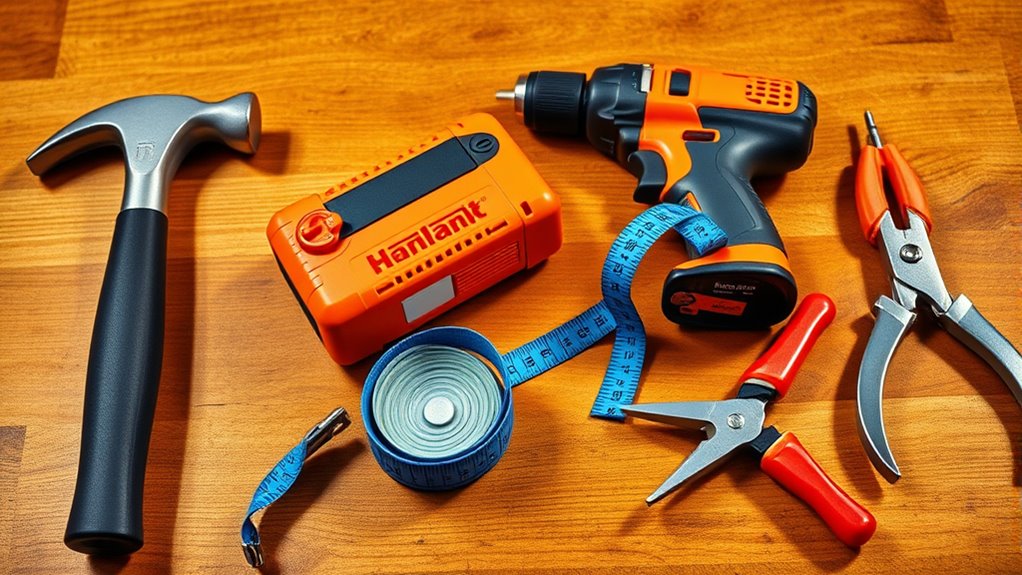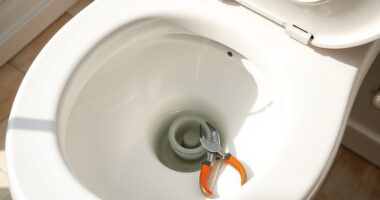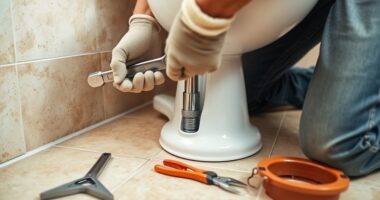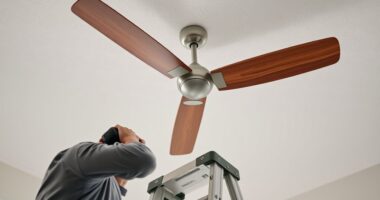To keep your home well-maintained, you should own essential tools like a good hammer, screwdrivers, pliers, and a utility knife for quick repairs. Power tools such as a cordless drill, along with measuring devices like a tape measure and level, make projects easier. Don’t forget safety gear like gloves and goggles, plus proper tool storage. Mastering these basics helps you handle most repairs efficiently; stay with us to learn more about keeping your tools in top shape.
Key Takeaways
- A versatile set of hand tools such as a hammer, screwdrivers, pliers, utility knife, and adjustable wrenches for common repairs.
- Power tools like a cordless drill, along with drill bits and level for faster, precise tasks.
- Measuring and cutting tools including a tape measure, level, and utility knife to ensure accuracy.
- Safety gear such as gloves, goggles, and a flashlight to protect and work effectively in various conditions.
- Proper tool maintenance practices like cleaning, blade sharpening, and safe storage to extend tool lifespan.
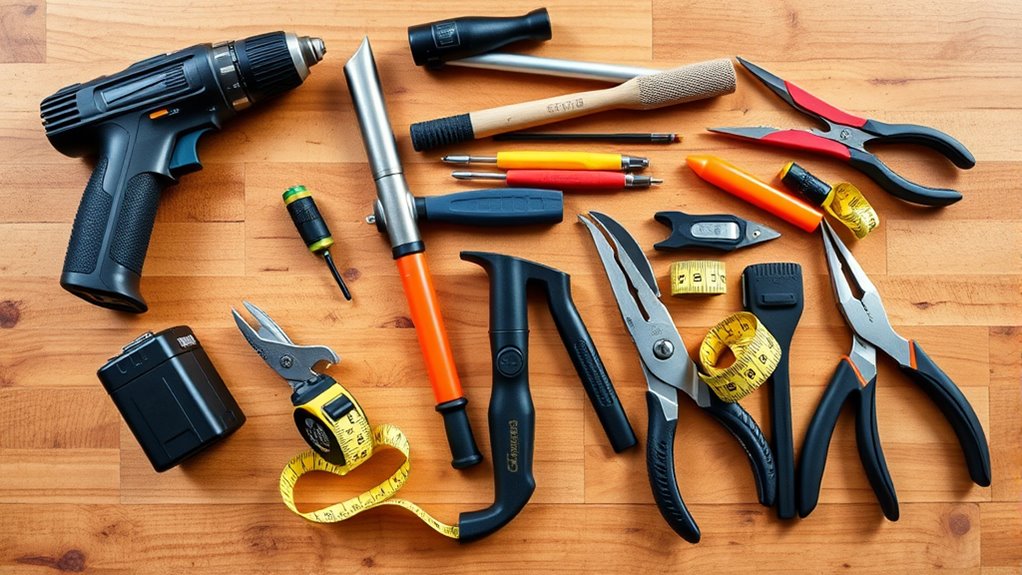
Owning a home means you’ll need a reliable set of tools to handle routine repairs and maintenance tasks. Whether you’re fixing a leaky faucet, hanging a picture, or tightening loose cabinet hinges, having the right tools makes the job easier and more efficient. Starting with the basics, a good hammer, screwdrivers (both Phillips and flat-head), and a set of pliers are essential. They’re versatile and will cover most of your DIY repairs in a pinch. As you gain confidence, you’ll realize that maintaining your tools is just as important as owning them. Regular tool maintenance guarantees your tools stay in good shape, work effectively, and last longer. Clean your tools after use, keep blades sharp, and store them properly to prevent rust. When your tools are well-maintained, you’ll find repairs go faster and become less frustrating.
Having reliable tools and maintaining them makes DIY repairs easier and more efficient.
Having a cordless drill is a game-changer, especially for tasks like installing shelves or assembling furniture. It makes DIY repairs quicker and less strenuous. Pair it with a set of drill bits and screwdriver attachments, and you’re ready to tackle most projects around the house. A level and tape measure are also must-haves for ensuring everything is aligned and to exact measurements, saving you from costly mistakes. A utility knife is handy for cutting drywall, opening packages, or trimming materials, and a set of adjustable wrenches helps with plumbing or appliance repairs. Additionally, understanding essential home repair skills can help you handle common issues more effectively.
Your toolbox should also include a flashlight or headlamp for working in poorly lit areas, especially during power outages or when working in tight spaces. Safety gear, like gloves and goggles, should never be overlooked to protect yourself during DIY repairs. As you develop your skills, you’ll see the importance of maintaining your tools—sharpening blades, replacing worn parts, and keeping everything clean. Proper tool maintenance not only extends the life of your tools but also improves safety and efficiency. When your tools are in top shape, repairs are quicker, and your home remains a safe, comfortable place.
In essence, investing in quality tools and caring for them is fundamental for every homeowner. It empowers you to handle repairs confidently, saves money on professional services, and keeps your home in excellent condition. With the right toolkit and a commitment to tool maintenance, you’ll be well-prepared to face any household challenge that comes your way.
Frequently Asked Questions
How Often Should I Replace My Home Maintenance Tools?
You might wonder how often you should replace your home maintenance tools. Generally, tools have a good tool lifespan if you follow a proper maintenance schedule. Regularly inspect your tools for wear and damage, and clean them after use. If they become dull, rusty, or broken, it’s time to substitute them. Staying proactive helps ensure your tools work efficiently and safely, saving you money and hassle in the long run.
Are There Eco-Friendly or Sustainable Tool Options Available?
You’re wondering if eco-friendly alternatives exist for your home tools. The good news is, many sustainable tool brands now offer options made from recycled or biodegradable materials, reducing environmental impact. These sustainable tools perform well and help you cut down on waste. By choosing eco-friendly alternatives, you support a greener planet while maintaining your home efficiently. Explore sustainable tool brands to find durable, eco-conscious options for everyday maintenance tasks.
What Safety Gear Is Recommended for DIY Home Repairs?
Imagine your safety shield in a storm—your personal protective equipment. For DIY repairs, you should wear safety glasses, gloves, and a dust mask to guard against sparks, splinters, or debris. Keep emergency preparedness gear nearby, like a fire extinguisher and first aid kit, ready to act swiftly. Prioritizing these safety essentials guarantees your home repairs remain a controlled, safe adventure rather than a risky voyage.
Can I Rent Tools Instead of Buying Them?
Yes, you can rent tools instead of buying them. Tool rental is a great option if you only need a tool temporarily or for a specific project, saving you money. It also offers a cost comparison advantage, as renting often costs less than buying new equipment. Plus, rental shops usually maintain tools in good condition, ensuring safety and reliability during your DIY projects.
How Do I Organize My Toolbox Efficiently?
To organize your toolbox efficiently, start with proper storage solutions like a sturdy toolbox or wall-mounted shelves. Use toolbox labeling to categorize tools by type or project, making everything easy to find. Keep frequently used tools at the top or in accessible compartments. Regularly declutter and clean your toolbox to prevent clutter buildup. This approach saves time and keeps your tools in good condition, ensuring you’re always ready for any home project.
Conclusion
Having these essential tools on hand makes you prepared for most home projects and repairs. Remember, a stitch in time saves nine—you’ll avoid bigger issues down the line if you stay proactive. With the right tools, you can tackle small problems before they become costly headaches. So, invest in these basics now, and you’ll always be ready to handle whatever comes your way. After all, a well-equipped home is a happy home.
